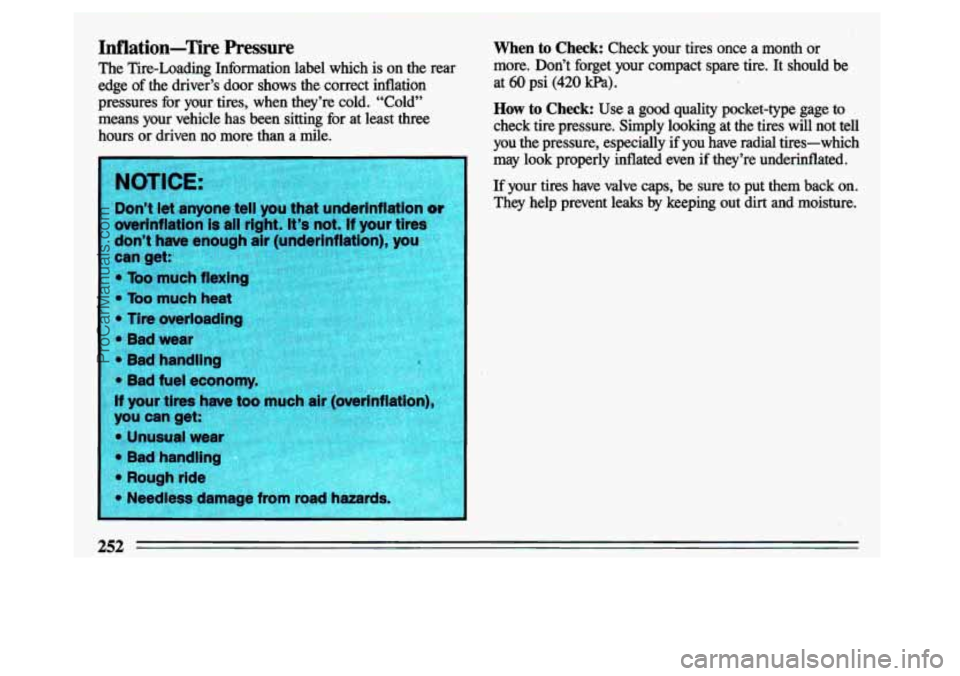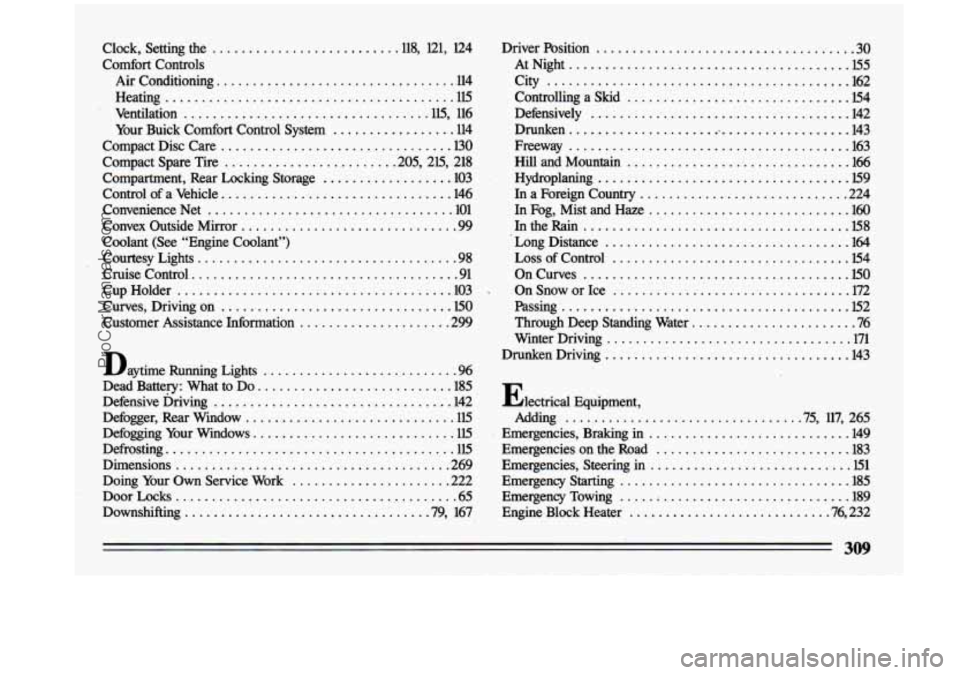1993 BUICK CENTURY spare tire
[x] Cancel search: spare tirePage 220 of 324

Compact Spare Tire
Although the compact spare was fully inflated when your
vehicle was new, it can lose air after a time.
Check the
inflation pressure regularly. It should be
60 psi
(420 Wa). The compact spare is made to go up to 3,000
miles (5 0o0 km), so you can finish your trip and have
your full-size tire repaired or replaced where you want.
Of course, it’s best to replace your spare with a full-size
tire as soon as you can. Your spare will last longer and be
in good shape in case you need
it again.
on’t take your compact spare th
utomatic car wash with guide
ompact spare can get caught damage the tire and whe
her parts
of your vehicle.
Don’t use your compact spare on some other vehicle.
And don’t
mix your compact spare or wheel with other
wheels or tires. They won’t
fit. Keep your spare and its
wheel together.
s too. Don’t us
ProCarManuals.com
Page 253 of 324

n
ACAUTION:
Things you put inside your vehicle can strike
and injure people
in a sudden stop or turn, or
In a crash.
* Put things In the trunk or rear area of your
vehicle. In
a trunk, put them as far forward
as you can. Try to spread the weight evenly.
* Never stack heavier things, IPke suitcases,
inside the vehicle
so that some of them are
above the tops
of the seats.
* When you carry something inside the
vehicle, secure
it whenever you can.
* Don’t leave a seat folded down unless you
need to.
Tires
We don’t make tires. Your new vehicle comes with high
quality tires made
by a leading tire manufacturer. These
tires are warranted by the tire manufacturers and their
warranties are delivered with every new Buick. If your spare tire is a different brand than your road tires, you
will have a tire warranty folder from each
of these
manufacturers.
A CAUTION:
Poorly maintained and improperly used tires
are dangerous.
0 Overloading your tires can cause
overheating as a ngsult
of too much friction.
Mu could
have an air-out and a serious
accident.
See “Loading bur Vehicle” in the
Index.
* Underlnflated tires pose the same danger as
overloaded tires. The resulting accident
could cause serious injury. Check
all tires
frequently to maintain the recornmended
pressure. Tire pressure should
be checked
when your tires are cold.
* Overinflated tires are more likely to be cut,
punctured, or broken
by a sudden Impact,
such as when you
hit a pothole. Keep tires at
the recommended pressure.
tread
Is badly worn, or If your tlps have
been damaged, replace them.
* Worn, old tires can cause accidents. If your
251
ProCarManuals.com
Page 254 of 324

Inflation-Tire Pressure When to Check: Check your tires once a month’or
The Tire-Loading Inforlnation label which is on the rear
’ more. Don’t forget your compact spare tire. It should be
edge of the driver’s door shows
the correct inflation at 60 psi (420 kPa).
pressures for your tires, when they’re cold. “Cold”
means your vehicle has been sitting for at least
three
hours or driven no more than a ‘mile.
How to Check: Use a good quality pocket-type gage to
check tire pressure. Simply looking at the tires will not tell
you the pressure, especially if you have radial tires-which
may look properly inflated even if they’re underinflated.
If your tires have valve caps, be sure to put them back on. \
They help prevent
leaks by keeping out dirt and moisture.
252
ProCarManuals.com
Page 257 of 324

*
I A CAUTION:
Mlxing tires could cause you to lose control
while driving.
If you mlx tires of different sizes
or types (radial and bias-belted tires) the
vehlcle may not handle
properly, and you
could have
a crash. Be sure to use the same
size and type
tires on all four wheels. It’s all
right to drive wlth your compact spare,
though.
It was developed far use on your
vehicle.
I
Uniform Tire Quality Grading
The following information relates to the system developed
by the United States National Highway Traffic Safety
Administration which grades tires by treadwear, traction
and temperature performance. (This applies only to
vehicles
sold in the United States.)
Treadwear
The treadwear grade is a comparative rating based on the
wear rate of the tire when
tested under controlled
conditions on a specified government test course. For
example, a tire graded
150 would wear one and a half
(1%) times as well on the government course
as a tire
graded
100. The relative performance of tires depends
upon the actual conditions of their use, however, and may
depart significantly from the norm due to variations
in
driving habits, service practices and differences in road
characteristics and climate.
Traction-A, B, C
The traction grades, from highest to lowest are: A, B,
and C. They represent the tire’s ability to stop on wet
pavement as measured under controlled conditions on specified government test surfaces of asphalt and
concrete.
A tire marked C may have poor traction
performance.
Warning: The traction grade assigned to this tire is based
on braking (straight-ahead) traction tests and does not
include cornering (turning) traction.
255
ProCarManuals.com
Page 267 of 324

Vehicle Identification Number 0
1
0
SAMPLE4UXPM072675 (cml
This is the legal identifier. for your Buick. It appears on a
plate in the front comer
of the instrument panel, on the
driver’s side.
You can see it if you look through the
windshield from outside, your vehicle. The VIN also
appears on the Vehicle Certification and Service
Parts
labels and the certificates of title and registration.
Engine Identification
The eighth character in your VIN is the engme code for
your
GM engine. This code will help you identify your
engine, specifications, and replacement parts
in this
section.
Service Parts Identification Label
You’ll find this label on your spare tire cover in the coupe
or sedan.
In the wagon, you’ll find the label on the wheel
well (remove the spare tire cover to expose the wheel
well). It’s very helpful
if you ever need to order parts.. On
this label is:
Your VIN.
Its model designation.
Paint information.
A list of all production options and special equipment.
Be sure that
this label is not. removed from. the vehicle.
Add-on Electrical Equipment
265
ProCarManuals.com
Page 311 of 324

Clock. Setting the ......................... .118. 121. 124
Comfort Controls
Air Conditioning
................................. 114
Heating
............... .. ........................ 115
Ventilation
................................. .ll5. 116
Your Buick Comfort Control System
................. 114
Compact Disc Care
................................ 130
Compact Spare Tire ....................... .205. 215. 218
Compartment. Rear Locking Storage
.................. 103
Control of a Vehicle
................................ 146
Convenience Net
.................................. 101
Convex Outside Mirror
.............................. 99
Coolant (See “Engine Coolant”)
Courtesy Lights
.................................... 98
Cruisecontrol
..................................... 91
CupHolder
...................................... 103
Curves. Driving on
................................ 150
Customer Assistance Information ..................... 299
DaytimeR-ngLights
........................... 96
Dead Battery: What to Do
........................... 185
Defensive Driving
................................. 142
Defogger. Rear Window
............................. 115
Defogging Your Windows
............................ 115
Defrosting ........................................ 115
Dimensions
....................................... 269
Doing Your Own Service Work
...................... 222
DoorLoc
ks ....................................... 65
Downshifting
.................................. .79, 167
Driver Position .................................... 30
AtNight
....................................... 155
City .......................................... 162
Controlling a Skid
............................... 154
Defensively
.................................... 142
Drunken
........................................ 143
Freeway
....................................... 163
Hill and Mountain
............................... 166
Hydroplaning
................................... 159
In a Foreign Country
............................. 224
In Fog, Mist and Haze ............................ 160
IntheRain
..................................... 158
LongDistance .................................. 164
Loss of Control ................................. 154
OnCurves
..................................... 150
On Snow or Ice ................................. 172
Passing
......................................... 152
Through Deep Standing Water
....................... 76
Winter Driving
................................... 171
Drunken Driving
.................................. 143
Electrical Equipment,
Adding
................................. 75, 117, 265
Emergencies, Braking in
............................ 149
Emergencies on the Road
........................... 183
Emergencies, Steering in
............................ 151
EmergencyStarting
................................ 185
Emergency Towing ..... .......................... 189
Engine Block Heater
........................... .76, 232
ProCarManuals.com
Page 317 of 324

Snowstorm (see “Winter Driving”)
Sound Equipment. Adding
........................... 117
Sound Systems (see ‘Audio Systems”)
Spare Tire. Compact.
...................... .205. 215. 218
Specifications and Capacities
................... .270. 272
Specifications. Engine
......................... .270. 272
Speed Control (see “Cruise Control”)
Speedometer
..................................... 106
Stains. Removing
.................................. 258
Starting .Your Engine
................................ 74
Starting Your Vehicle if the Battery
is Dead
Steering (see “Jump Starting”)
In Emergencies
.................................. 151
Off-Road Recovery
.............................. 152
Tips
.......................................... l50
Steering Wheel. Tilt ................................ 86
Stereo Sound Systems (see “Audio Systems”)
Storage Armrest
....................................... 103
Convenience Net
................................ 101
Rear Locking Compartment
........................ 103
Rear Storage Security Cover
....................... 101
Storing Your Vehicle ............................... 244
Stuck. If You Are
.................................. 219
Sun Visors
........................................ 100
Supplemental Inflatable Restraint (Air Bag)
.............. 35
TAlgate Ajar warning Light
........................ 111 Tape Player (see “Audio Systems”)
Technical Facts
& Specifications
Bulbs
......................................... 269
Electrical Equipment. Add-on
.............. .75. 117. 265
Fluid Capacities
& Types ................ .270. 272. 292
Fuseusage
.................................... 267
Service
Parts Identification Label ................... 265
Vehicle Identification Number (VIN)
................ 265
Temperature Warning Light
.......................... 110
Theft
............................................ 71
Thermostat
...................................... 241
Tilt Steering Wheel
................................. 86
Time. Setting the
.......................... .118. 121. 124
Tire hading
................................ .249. 251
Tires
........................................... 251
Chains
................................... .218. 257
Flat. Changing
.................................. 205
Inflation
....................................... 252
Inspection
& Rotation ............................ 253
Loading
................................... 249. 251
Pressure ....................................... 252
QualityGrading
................................. 255
Spare. Compact
......................... .205. 215. 218
Wear Indicators
................................... 254
Wheel Replacement
......................... .256. 257
When to Replace Wheels
.......................... 256
Winter Driving. and Tires
......................... 171
Torquebk
..................................... 170
BuyingNew
.................................... 254
Wheel Alignment and Tire Balance
.................. 256
ProCarManuals.com